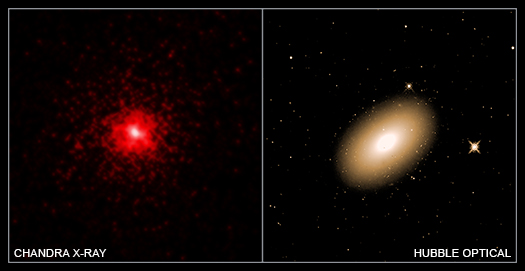X-Rays Help Prove Some Galaxies are True Relics of the Ancient Universe

Professor David Buote
We welcome Professor David Buote as our guest blogger. Buote was one of the first Chandra Postdoctoral Fellows and is now a Professor at the University of California at Irvine. He has studied X-rays from massive elliptical galaxies and galaxy clusters since the time he was a graduate student. His new work with Aaron Barth on the dark matter in a relic elliptical galaxy is the subject of our latest press release.
This year marks the 20th anniversary of the Chandra X-ray Observatory and a chance to celebrate its many and diverse accomplishments. A critical aspect of Chandra's impact on astrophysics is its synergies with observations of phenomena throughout the electromagnetic (EM) spectrum and through other channels like gravity waves and neutrinos. Our study highlights how studies of the X-ray emission of a rare type of galaxy complement and augment what has been learned from observations of the stellar light at longer wavelengths.
Galaxies are broadly divided into two types — disks and spheroids — with substantial overlap in their properties. The spheroids — or elliptical galaxies — are approximately round but range in shape as observed on the sky from nearly circular to elongated somewhat like an American football viewed from the side. Most of what we know about the stars in galaxies comes from observations of visible light photons with lots of help from observations in the nearby ultraviolet and infrared (IR) parts of the EM spectrum.
A major new result obtained from observations over a decade ago is that the stellar sizes of massive galaxies (as judged by the radius enclosing half the total stellar light of a galaxy, called the “stellar half light radius”) increase as the universe ages. This and other lines of evidence support a two-stage picture of galaxy formation. The first stage involves the "rapid" (few billion years) cooling and assembly of a compact, dense "red nugget" formed about 10 billion years ago that forms the core of present-day galaxies. The longer, drawn-out second phase involves a relatively gentle addition and assimilation of smaller galaxies that merge with the red nugget. This second stage thus results in the piling on of a more extended, diffuse stellar halo essentially surrounding the embedded core red nugget.
Our story begins about five years ago with an intriguing discovery of candidate relic elliptical galaxies as viewed by their stellar properties from optical/IR observations. These galaxies are all nearby ("low-redshift," i.e., light travel time to us a small fraction of the age of the universe) and possess very old stellar populations almost as old as the universe, implying they are relics of star formation that occurred long ago. Critically, their stellar sizes are too small to match those of present-day galaxies of the same total stellar masses. But the sizes are an excellent match to those of the red nuggets — galaxies that existed 10 billion years ago!
These relic galaxies therefore appear to be red nuggets that somehow skipped the long second stage of evolution. For this to have taken place, these galaxies must have experienced a very unusual and isolated evolution after collapsing to a red nugget some 10 billion years ago. Galaxies possessing such a rare evolutionary history would provide an exciting new way to test theoretical models of galaxy formation. In addition, if these relic galaxies are indeed direct descendants of the red nuggets, they afford astronomers the opportunity to study the properties of red nuggets with a level of detail not possible for direct study of faint high-redshift galaxies.
A crucial ingredient, however, is missing from this picture. It is well established that most of the mass in galaxies is in the form of a mysterious dark matter, the presence of which is known only from its gravitational influence on normal matter that we observe with our telescopes. While the dark matter is always more extended than the stars in a galaxy, it should behave analogously to the stars in these relic galaxies; i.e., the "size" of the dark matter halo should be much more compact than the corresponding sizes of the dark matter halos in nearby galaxies of similar total mass. The usual way the dark matter "size" is represented is in terms of a "concentration parameter," for which large values of the concentration indicate more centrally concentrated dark matter. I will use this terminology henceforth.
Observations of the motions of the stars in a galaxy can be inferred by measuring the apparent change in wavelength of light — the Doppler shifts — as a star moves towards or away from us. These and other methods typically provide a powerful probe of the mass profiles of elliptical galaxies, that is the amount of mass at different distances from the center of the galaxy. However, such measurements quickly become challenging for the area outside the stellar half-light radius where the dark matter is most prominent. Consequently, stellar dynamical studies currently do not constrain the dark matter halo concentration in the candidate relic galaxies.
Many massive elliptical galaxies, on the other hand, contain hot interstellar gas that emits in low-energy X-rays observable by Chandra and extends well outside the stellar (optical/IR) half-light radius and far out into the dark matter halo. This hot gas reveals the distribution of dark matter by the way the gravitational field shapes the gas density and temperature variations with radius. This is another example in astronomy where the speeds of particles (here via gas temperature) moving in a gravitational field are used to measure the total mass responsible for establishing the field. When the hot gas exhibits a "hydrostatic" balance at any radius between the outward force of hot gas pressure and the inward force of gravity, the density and temperature profiles of the gas measured from X-rays allow the total mass within that radius to be measured.
My colleague Aaron Barth, from University of California, Irvine, and I searched the Chandra data archive to see if any of these elliptical galaxies proposed to be relics of the red nuggets based on their stellar properties also had sufficient X-ray emission for a hydrostatic analysis of its dark matter. Out of 16 such candidate galaxies, we found two suitable for detailed X-ray study, the best of which is Mrk 1216 owing to its high X-ray luminosity and emission extending well out into its dark matter halo. Since the existing data in the archive are shallow observations with fairly noisy data, we were only able to obtain rough constraints.
Our initial analysis of the shallow Chandra observation of Mark 1216 allowed for a large range of dark matter profiles, but the data favored solutions with dark matter halo concentrations above the average for nearby galaxies — with a large part of the solution space allowing for dark matter profiles having very large concentrations highly inconsistent with those expected for nearby galaxies of similar total mass.
We reported these initial results for Mrk 1216 (and another galaxy) based on the shallow archive data in an article in the Astrophysical Journal. Our discovery of the X-ray emission in Mrk 1216 occurred contemporaneously with that of another team, although they did not measure the dark matter halo concentration.
Using as a key motivation the preliminary evidence for a high dark matter concentration we proposed successfully for a deep re-observation of Mrk 1216 with Chandra in Cycle 19 (proposals to observe with Chandra from scientists are reviewed every year, or cycle.). The new observation added almost 10 times the number of X-ray photons previously detected. With this great boost in data quality, we were able to measure the mass profile much more precisely than before which now clearly showed that the dark matter halo has a very high concentration. This measurement provides the first evidence that the small dark matter halo "size" corroborates the picture of a relic galaxy initially indicated by the small stellar size and old stellar population.
Motivated by the success of Mrk 1216, we are actively searching for more of these candidate "relic" galaxies that possess extended and luminous X-ray emission from hot gas to obtain a broader picture of the dark matter profiles of these galaxies and, at the same time, glean new details of the dark matter profiles of high-redshift galaxies. We also look forward to future missions with instruments possessing the spectral resolution and sensitivity to measure directly the hot gas motions through Doppler techniques to refine the hydrostatic models.
Our study would not have been possible without the high spatial resolution of Chandra allowing us to distinguish between the gravitational fields produced by the stars and dark matter. We are truly grateful to the late Riccardo Giacconi for his scientific vision and the leading role he played in the rapid development of the field of X-ray astronomy from its birth almost 60 years ago leading to the huge success that is the Chandra X-ray Observatory.

